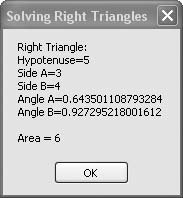Recipe 6.17. Solving Right Triangles
ProblemYou want to calculate all the remaining sides and angles of a right triangle given two known parts of the triangle. SolutionSample code folder: Chapter 06\RightTriangle Create a RightTriangle class that calculates all parts of a right triangle given any two of its parts. DiscussionThe parts of a right triangle we are concerned with are the two sides A and B adjacent to the right angle, the hypotenuse (the side opposite the right angle), and the two angles formed where the hypotenuse meets sides A and B. If you know any two of these values, all the rest can be determined. There are many ways to set up the RightTriangle class, and the technique chosen here is not the only reasonable approach to the problem. We chose to use the initializing function New() to define the triangle by passing in nonzero numbers for the known parts and a value of zero for the unknowns. The IntelliSense pop-up prompt makes it easy to remember what parts of the triangle are passed in at each parameter position. It's as easy as filling in the blanks. The code for the RightTriangle class is as follows: Public Class RightTriangle Private StoredSideA As Double Private StoredSideB As Double Private StoredHypotenuse As Double Private StoredAngleA As Double Private StoredAngleB As Double Public Sub New(ByVal hypotenuse As Double, _ ByVal sideA As Double, ByVal sideB As Double, _ ByVal angleA As Double, ByVal angleB As Double) Me.StoredHypotenuse = hypotenuse Me.StoredSideA = sideA Me.StoredSideB = sideB Me.StoredAngleA = angleA Me.StoredAngleB = angleB Me.Resolve() End Sub Public ReadOnly Property SideA() As Double Get Return StoredSideA End Get End Property Public ReadOnly Property SideB() As Double Get Return StoredSideB End Get End Property Public ReadOnly Property AngleA() As Double Get Return StoredAngleA End Get End Property Public ReadOnly Property AngleB() As Double Get Return StoredAngleB End Get End Property Public ReadOnly Property Hypotenuse() As Double Get Return StoredHypotenuse End Get End Property Private Sub Resolve() ' ----- Figure out the missing (zero) parts of the ' triangle. Start with the angles. If (StoredAngleA = 0.0#) And _ (StoredAngleB <> 0.0#) Then _ StoredAngleA = Math.PI / 2 - StoredAngleB If (StoredAngleB = 0.0#) And _ (StoredAngleA <> 0.0#) Then _ StoredAngleB = Math.PI / 2 - StoredAngleA If (StoredAngleA <> 0.0#) And _ (StoredHypotenuse <> 0.0#) Then _ StoredSideB = StoredHypotenuse * _ Math.Cos(StoredAngleA) If (StoredAngleB <> 0.0#) And _ (StoredHypotenuse <> 0.0#) Then _ StoredSideA = StoredHypotenuse * _ Math.Cos(StoredAngleB) If (StoredAngleA <> 0.0#) And _ (StoredSideA <> 0.0#) Then _ StoredHypotenuse = StoredSideA / _ Math.Sin(StoredAngleA) If (StoredAngleB <> 0.0#) And _ (StoredSideB <> 0.0#) Then _ StoredHypotenuse = StoredSideB / _ Math.Sin(StoredAngleB) If (StoredAngleA <> 0.0#) And _ (StoredSideB <> 0.0#) Then _ StoredHypotenuse = StoredSideB / _ Math.Cos(StoredAngleA) If (StoredAngleB <> 0.0#) And _ (StoredSideA <> 0.0#) Then _ StoredHypotenuse = StoredSideA / _ Math.Cos(StoredAngleB) ' ----- Now calculate the sides. If (StoredSideA <> 0.0#) And _ (StoredSideB <> 0.0#) Then _ StoredHypotenuse = Math.Sqrt(StoredSideA ^ 2 + _ StoredSideB ^ 2) If (StoredSideA <> 0.0#) And _ (StoredHypotenuse <> 0.0#) Then _ StoredSideB = Math.Sqrt(StoredHypotenuse ^ 2 - _ StoredSideA ^ 2) If (StoredSideB <> 0.0#) And _ (StoredHypotenuse <> 0.0#) Then _ StoredSideA = Math.Sqrt(StoredHypotenuse ^ 2 - _ StoredSideB ^ 2) If (StoredAngleA = 0.0#) Then StoredAngleA = _ Math.Asin(StoredSideA / StoredHypotenuse) If (StoredAngleB = 0.0#) Then StoredAngleB = _ Math.Asin(StoredSideB / StoredHypotenuse) End Sub Public Overrides Function Tostring() As String ' ----- Display all values of the triangle. Dim result As New System.Text.StringBuilder result.AppendLine(" Right Triangle:") result.AppendLine("Hypotenuse=" & _ StoredHypotenuse.ToString) result.AppendLine("Side A=" & StoredSideA.ToString) result.AppendLine("Side B=" & StoredSideB.ToString) result.AppendLine("Angle A=" & StoredAngleA.ToString) result.Append("Angle B=" & StoredAngleB.ToString) Return result.ToString() End Function End Class The core calculations of this class are performed in the private Resolve() function. There, the various triangle parts are tested to see if they are nonzero, and the appropriate calculations are performed to start filling in the blanks for the unknowns. Resolve() is called just once, at the moment when the RightTriangle object is instantiated. All the parts of the right triangle are later returned as required via read-only properties. Visual Basic internally always assumes angles to be in radians, even though degrees are the most commonly used units for angles among the general population. It's tempting to use degrees in user-defined classes and procedures, but for consistency this book will assume radians throughout. The following sample code creates an instance of the RightTriangle object and uses it to calculate a typical right triangle. In this example, the lengths of sides A and B are known. All other parts of the triangle are passed as zero when the RightTriangle is instantiated: Dim testTriangle As RightTriangle Dim area As Double testTriangle = New RightTriangle(0, 3, 4, 0, 0) area = (testTriangle.SideA * testTriangle.SideB) / 2 MsgBox(testTriangle.Tostring & vbNewLine & _ "Area = " & area.ToString) Figure 6-17 shows the results of calculating the missing parts of a right triangle with sides A and B of lengths 3 and 4. Figure 6-17. Using the RightTriangle class to calculate unknown parts of a right triangle See AlsoSearch for "right triangle" on the Web for more information about this subject (see, for example, http://mathworld.wolfram.com/RightTriangle.html). |
EAN: 2147483647
Pages: 400